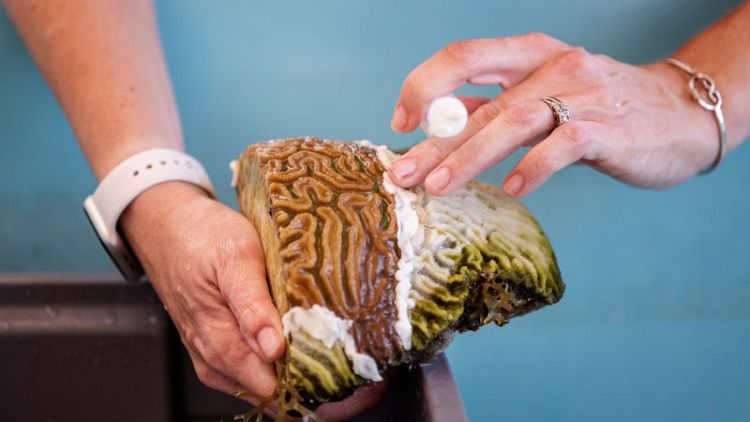By Lucas Jackson and Chris Prentice
ST THOMAS, Virgin Islands/NEW YORK (Reuters) - Off the coast of St. Thomas in the U.S. Virgin Islands, a group of scientists is tearing a reef apart in a feverish attempt to save some of its coral.
They are battling a fast-moving, lethal disease that researchers say is unprecedented in the speed with which it can damage large numbers of coral species across the Caribbean Sea.
Breaking their cardinal rule to never touch the coral, the scientists are removing diseased specimens to try to stop the disease spreading and save what remains.
Meanwhile, researchers and divers in Florida, where the disease was first spotted in 2014, are also removing coral samples and shipping them to places as far-flung as Kansas and Oklahoma, in a last-ditch effort to save the 20 species or more thought to be susceptible to what has been dubbed Stony Coral Tissue Loss Disease.
The disease prompts rapid tissue loss, appearing first as white patches that sprawl out across the coral, before eventually stripping it of colour and life altogether.
About half the coral species that make up Florida's reef tracts and about a third of those throughout the Caribbean are vulnerable to the disease, at a time when the delicate ecosystems are already threatened by climate change.
Overall, Florida's Upper Keys have seen greater than 40% loss in coral cover between 2013 and 2018, according to the Florida Fish and Wildlife Commission.
Stony Coral Tissue Loss Disease https://tmsnrt.rs/2nfybsM has been identified in seven other Caribbean localities, according to the Florida Sea Grant, a university-based program funded by the federal government. Unlike the more well-known coral bleaching phenomenon, coral typically cannot recover from Stony Coral Tissue Loss Disease. The species fall victim to it at different paces, with a mortality rate of 66-100 percent.
"I have never seen anything that affects so many species, so quickly and so viciously - and it just continues," said Marilyn Brandt of the University of the Virgin Islands, who is one of the researchers involved in the efforts to save the reefs near St. Thomas.
"All the diseases I've studied in the past could be considered like the flu. They come every year, seasonally, and sometimes there are worse outbreaks. This thing is more like Ebola. It's a killer, and we don't know how to stop it."
Brandt's team first spotted the disease along the west coast of St. Thomas in January and have launched a frantic effort to try to stem its advance, resorting to removing diseased corals with a hammer and chisel to try to salvage the rest.
"The coral basically liquefies from the inside out," Brandt said.
WEAKENED SYSTEM
The disease was first identified near Miami, Florida, where the port was conducting a dredging project, and has now spread throughout almost all of the state's reef tract.
The coral in the area were already stressed from the dredging and a recent bleaching event, so it was unsurprising they got hit with a disease, the scientists told Reuters. Like with a human body, a weakened immune system can make coral more susceptible to disease.
"We tend to just study these events. We monitor them. We try to research what to do. We just watch it happen and assume that Mother Nature is going to be able to take the reins and everything's going to be fine," said Maurizio Martinelli, Coral Disease Response Coordinator at the Florida Sea Grant.
But the scale of the new disease has led to a more urgent approach. Large coral individuals that scientists have estimated to be hundreds of years old have been dying within a matter of several weeks, according to the scientists' estimates.
"We can't just watch these corals all die in front of us," Martinelli said.
Corals, which cover about 1 percent of the Earth's surface, are animals that settle on the ocean floor and support more sea life than any other marine environment. As well as supporting thousands of species of plants, fish and other sea life, they draw huge numbers of tourists, scientists and divers.
They also provide a natural barrier to flooding, preventing $1.8 billion worth of damages to buildings, business and coastal economies and protecting more than 18,000 citizens annually in the United States alone, according to a 2019 U.S. Geological Survey report.
But the federal budget to protect coral reefs has been largely unchanged for years, and that's left coral science in the "Middle Ages," said coral scientist William Precht.
The disease is likely the deadliest for coral since so-called white-band disease emerged in the 1970s, almost wiping out two kinds of coral, he said.
"Now, we're looking at a similar type of disease, but instead of affecting two species, it hits 22," said Precht.
"The end result could be catastrophic."
(Reporting by Lucas Jackson in the Virgin Islands and Chris Prentice in New York, Editing by Rosalba O'Brien)
